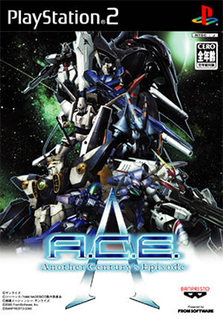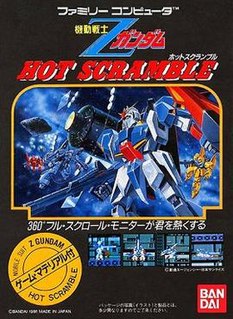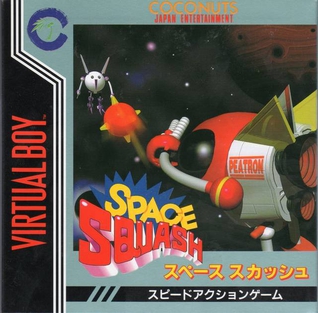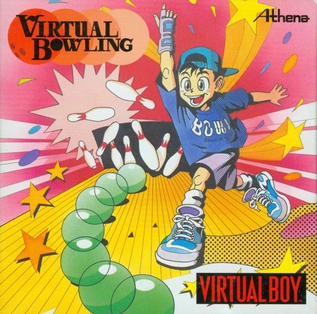
Gundam is a Japanese military fiction media franchise/media mix. Created by Yoshiyuki Tomino and Sunrise, the franchise features giant robots, or mecha, with the name "Gundam". The franchise began on April 7, 1979, with Mobile Suit Gundam, a TV series that defined the "real robot" mecha anime genre by featuring giant robots called mobile suits in a militaristic setting. The popularity of the series and its merchandise spawned a franchise that includes 50 TV series, films and OVAs as well as manga, novels and video games, along with a whole industry of plastic model kits known as Gunpla which makes up 90 percent of the Japanese character plastic-model market.
Super Robot Wars, known in Japan as Super Robot Taisen, is a series of tactical role-playing video games produced by Bandai Namco Entertainment, formerly Banpresto. Starting out as a spinoff of the Compati Hero series, the main feature of the franchise is having a story that crosses over several popular mecha anime, manga and video games, allowing characters and mecha from different titles to team up or battle one another. The first game in the franchise was released for the Game Boy on April 20, 1991. Later spawning numerous games that were released on various consoles and handhelds. Due to the nature of crossover games and licensing involved, only a few games have been released outside Japan, and in English. The franchise celebrated its 25th anniversary in 2016, and its 30th anniversary in 2021.
SD Gundam G Generation is a series of strategy-RPG video games that focus on the Gundam anime franchise.

Jack Bros. is an action video game developed and published by Atlus for the Virtual Boy, released in late 1995 in Japan and North America. It is a spin-off from Atlus' video game series Megami Tensei, and was the first entry to be released outside Japan.
SD Gundam is a media franchise that spawned from the Gundam franchise. SD Gundam takes the mecha from Gundam and expresses them in super deformed and anthropomorphic style.

Another Century's Episode is a 2005 third-person shooter video game published by Banpresto in Japan for the PlayStation 2. The player controls a mech from one of nine different anime robot franchises to destroy opposing forces before they steal a prized energy source for devious purposes. The game is divided into several different missions, where players use their mech and arsenal of weapons to fulfill mission objectives, ranging from destroying enemy machines to protecting a specific target.

Innsmouth no Yakata, also rendered as Insmouse no Yakata, is a 1995 first-person horror video game developed by Be Top and published by I'Max in Japan for the Virtual Boy. Assuming the role of a private detective in 1922, the player is tasked with escaping a monster-infested mansion with an artifact called the Necronomicon. The player navigates several mazelike levels that must be finished under a certain amount of time. It is loosely based on the H.P. Lovecraft novel The Shadow over Innsmouth, though the only similarity between the two is the presence of fish-like monsters. It received mixed reviews, with critics praising its Lovecraftian setting. Reception of the gameplay was mixed, with critical contemporary reviews from magazines Famitsu and VB Guide, though it was viewed positively for its ambition and uniqueness.

Vertical Force is a 1995 vertically scrolling shooter video game developed and published for the Virtual Boy by Hudson Soft for Japan and Nintendo for North America. The player controls a starship, the Ragnarok, that must destroy a malfunctioning supercomputer on a human colony planet before it wipes out all of mankind. Gameplay is similar to Hudson's own Star Soldier series, featuring power-up items that increase the player's abilities and parallax scrolling. The player can also move their ship farther into the background to avoid enemies and obstacles in the way.

Kidō Senshi Z Gundam: Hot Scramble, known outside Japan as Mobile Suit Z Gundam: Hot Scramble, is a 1986 rail shooter video game developed by Game Studio and published by Bandai for the Family Computer. It is based on the anime Mobile Suit Z Gundam, and is one of the first Gundam video games.

SD Gundam: Scad Hammers is a Mobile Suit Gundam video game developed by Bandai Entertainment Company (BEC) and published by Bandai Namco for the Wii console as a launch title for the system in Japan on December 2nd, 2006. The game is based on the SD Gundam spin-off franchise, with the game having heavy emphasis on the usage of the Gundam Hammer.

Super Robot Wars UX is a tactical role-playing game for the Nintendo 3DS developed by Banpresto and published by Bandai Namco Games. It is the first Super Robot Wars (SRW) game for the 3DS and was released in Japan on March 14, 2013. The theme of this game is "Possibilities".

Super Robot Wars T is a tactical role-playing game developed by B.B. Studio and published by Bandai Namco Entertainment. It is the eleventh standalone entry to the Super Robot Wars series and the third installment of the "International Era" series, with the game's continued focus on the massive crossover between different mecha anime series released in Japan. Released for the PlayStation 4 and Nintendo Switch, it was also released in Asia on March 20, 2019.

Bound High! is an unreleased action-puzzle video game that was in development by Japan System Supply and planned to be published by Nintendo on a scheduled 1996 release date exclusively for the Virtual Boy. In the game, players take control of a transforming robot named Chalvo through a series of levels riddled with hazardous obstacles to avoid across multiple worlds, while destroying or knocking out alien invaders off the area. The project was first conceptualized by designer and programmer Hideyuki Nakanishi, who wrote the idea on paper and placed it within a wall inside the offices of Japan System Supply, with his manager eventually greenlighting its development after seeing it.

Mr. Driller A is a 2002 puzzle video game developed and published in Japan by Namco for the Game Boy Advance. The fourth installment in its Mr. Driller series, players control one of seven characters and must make it to the bottom of the level by destroying colorful formations of blocks. A adds several new mechanics to the gameplay of its predecessors, such as a virtual pet named the "Pacteria" that players can grow and care for.

Super Robot Wars XO is a 2006 tactical role-playing video game developed and published by Banpresto for the Xbox 360 in Japan. Part of the company's Super Robot Wars series, it is an updated version of the GameCube installment Super Robot Wars GC (2004). Players control a fleet of mechas from a variety of super robot anime series, including Mobile Suit Gundam and Getter Robo, to defeat opponents on a grid-based map. XO combines tactical role-playing game mechanics with action sequences, which use stylized anime-esque cutscenes unique for each character.

V-Tetris is a 1995 puzzle video game developed by Locomotive and published by Bullet-Proof Software in Japan for the Virtual Boy. Its gameplay involves the player clearing horizontal lines by moving pieces of different shapes that descend onto the playing field by filling empty spaces in order to make completed lines disappear and gain points across three modes of play.

Space Squash is a 1995 sports video game developed by Tomcat System and published by Coconuts Japan Entertainment in Japan for the Virtual Boy. In the game, the player assume the role of a robot called Peatron to defeat a group of space pirates that have taken over the planet Animal Star on a intergalactic squash tournament. Its gameplay involves Peatron ricocheting a ball across a three-dimensional court and defeating the opponent on the other side in order to proceed further in the tournament.

Virtual Lab is a 1995 puzzle video game developed by Nacoty and published by J-Wing in Japan for the Virtual Boy. Its gameplay is reminiscent of Pipe Dream and the Game Boy title Chiki Chiki Tengoku, and involves the player moving worm pieces of different shapes that descend onto the playing field by linking or shutting their open orifices together to make them disappear and gain points across multiple levels.

Virtual Fishing is a 1995 fishing video game developed by Locomotive Corporation and published by Pack-In-Video in Japan for the Virtual Boy. In the game, the player participates in a series of fishing tournaments at various different locations by catching a large number of fishes with a high average weight under a time limit. Its gameplay consists of two segments and features two additional modes of play.

Virtual Bowling is a 1995 sports video game developed and published by Athena in Japan for the Virtual Boy. In the game, the player participates in a series of bowling tournamnets consisting of four 10-frame game matches at various alleys against computer-controlled opponents, in order to obtain a high score and progress further. Its gameplay, featuring three modes of play, is viewed from a first-person perspective.


















